It was bound to happen; it’s how these tall tales work. When you’re telling stories about the strongest man in the world, there’s a natural narrative pressure to make him even bigger and stronger and more unbeatable, over time.
Paul Bunyan, the mighty fabled lumberjack of the Northwoods, started out as seven feet tall, able to chop down tree after tree without stopping for rest. As the legend grew, Paul soared to forty feet tall. In the later tales, Paul could fell a tree just by shouting at it, and his bootprints created the 10,000 lakes of Minnesota.
The same thing happened to Superman. In 1938, he could pick up an automobile; in 1940, he demolished a house with a single blow of his fist; in 1943, he hit a baseball so hard that it circled the globe; and by 1949, he could crash a couple of moons together to make a sun for a distant planet that didn’t already have one.
So when it’s time for him to relax, he can’t sit around and watch TV. He needs to do something spectacular, and if that means creating a creepy private exploding wax museum, then the rest of us are going to have to come along for the ride.

Superman wasn’t actually the first adventure hero to build a dangerous secret clubhouse in the polar wastes. Doc Savage, a pulp science-hero who starred in 181 stories from 1933 to 1949, had a “Fortress of Solitude” in the Arctic, where he stored the super-scientific weapons that he confiscated from his enemies, and constructed some perilous inventions of his own. The igloo-shaped dome was first mentioned in story #1, Man of Bronze, and was referenced in almost every story after that.
The readers finally got to visit the place in 1938, in a story called Fortress of Solitude. In this story, the infamous John Sunlight, poetic genius of evil, happens across Doc Savage’s fresh-frozen storehouse, and steals a bunch of Doc’s toxic inventions, like a ray that turns people into black smoke. Doc feels a bit guilty for creating such a thing and leaving it around for people to find, so he hunts Sunlight through the Arctic, until the villain is apparently eaten by a polar bear, problem solved.
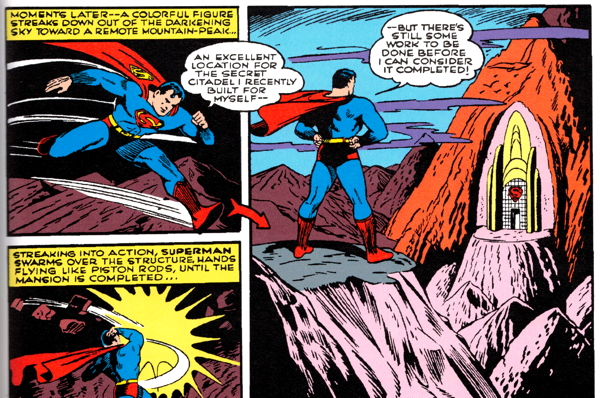
Once Superman gets running, he needs a home away from home as well, so that he can invent his own death rays and generally let his hair down. His first super-clubhouse was a “secret citadel” that he built into the side of a mountain outside Metropolis, in a 1942 story in Superman #17 that’s actually called “Muscles For Sale!”

The first thing that we see is his trophy room, which is filled with the most astonishing nonsense.
“An old ray-gun Luthor tried to annoy me with… Righab Bey‘s turban… a poster advertising my appearance with Jordan’s Circus… part of a broken axe Pedro attacked me with… a blanket given me by Wacouches, boy chief of the Chirroba tribe… Count Bergac‘s monocle… “The Archer‘s” arrow… Yes, these and many other trophies prove that crime does not pay!”
Okay, so many things. I might as well start with “part of a broken axe Pedro attacked me with,” about which I have no idea what he’s talking. Who could Pedro possibly be, and why would you keep part of his broken axe on display? And what happened to the other part?
The whole thing is very deep-cut fanservice, in a way that I wouldn’t expect from 1942. “Jordan’s Circus” goes all the way back to December 1938, in Action Comics #7. Righab Bey was in Superman #10 in 1941, Wacouches and Count Bergac in #11, Luthor in #12, and the Archer in #13. I guess when you’ve only been going for four years and you haven’t gone full-on science-fiction yet, you have to dig pretty deep to come up with a whole room full of trophies.
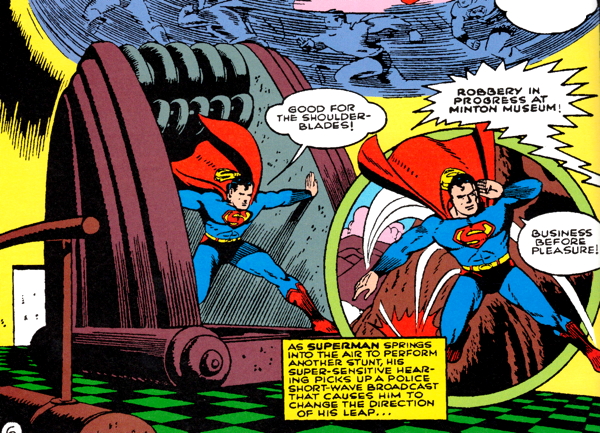
But the point of this first trip to the newly-installed secret citadel is to use the gym. “Now for some super-exercises!” says our hero. “Even a Superman must keep in trim!” Then he goes up and down a rope backwards, lifts up the chinning bar and lowers it to his chin, runs around a track so fast that he almost catches up with himself, and squeezes himself in an enormous vice, all of which feel pretty pointless given what he actually does on a daily basis, just by being Superman.
Superman returns to this mountain hideaway for exercise several times in 1942 and 1943, and then they forget about it for a while.

In spring 1949, right around the time that Doc Savage ran out of steam, Superman brings his new alien boyfriend Regor of Uuz to work out at his place. This is the first time that it’s referred to as his “Fortress of Solitude” and located in the polar wastes, which is such an obvious lift from Doc Savage that, in-universe, the character might have actually just moved out, and handed the keys over to Superman.

Superman uses the workout routine to humiliate Regor, and to make sure that he knows how strong and powerful Superman is, in the world’s first recorded example of super-negging.

In 1958, they finally got back to the icecapped Fortress of Solitude that everyone knows about. This issue, Action Comics #241, was Superman’s entry into the Silver Age, a period when they took continuity very seriously, and fully exploited any plot element that could be used to generate new story ideas. This was Superman aimed squarely at middle schoolers with diamond-tipped accuracy, and the stories in this period reflected the playtime adventures that kids enjoyed.
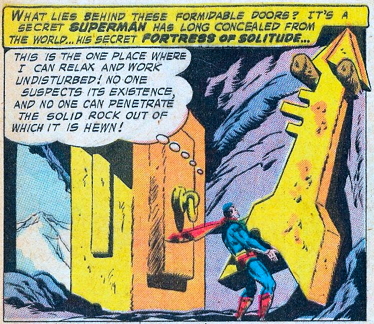
And what could be more middle-school than a secret clubhouse where everybody else has to keep out? Superman is the only person who can get into this re-Arcticed Fortress, because the key weighs several tons, and it’s cleverly disguised as an arrow marker to guide planes.
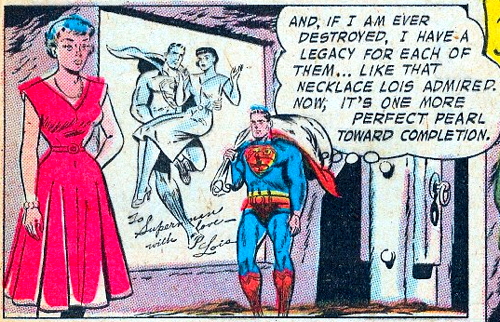
This isn’t just a 24-Carat Fitness anymore; in the Silver Age, everything has to be collected and labeled. The very first thing that Superman does is to go visit his secret wax museum dedicated to his nearest and dearest, as naturally it would be.
First stop is the Lois Lane Room, where he’s slowly assembling a necklace of flawless pearls that will be given to Lois in the event of his death, which he is apparently planning for.

And there’s also a Jimmy Olsen Room, where Superman is making a swell hand-made sports car, which again, will be presented to Jimmy when Superman dies.
Everything about the Fortress wax museum is unnerving, so the fact that it begins with an unasked-for rundown of Superman’s death gifts seems appropriate. You know, I don’t believe that the idea of handmade surprise inheritances has ever come up before in human civilization; I have no idea where Superman picks these things up.

There’s also a memorial to Batman in the Fortress, including a wax statue and what I suppose are wax replicas of some of the machines in the Batcave, including the Electronic Clue Analysis machine and the Crime Probability Predicter, both of which I now desperately want for myself. I wonder what Superman’s planning to do with those, after he dies?
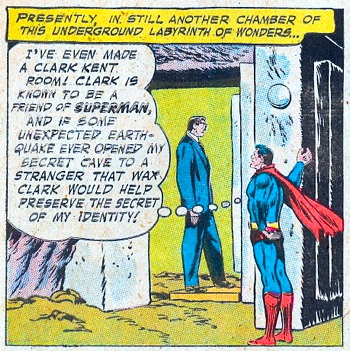
He’s also made a Clark Kent room, which he says is there to make sure that nobody would suspect that he’s Clark if they ever found their way into the Fortress, but who even knows with him anymore?

You wouldn’t think that this deranged personal tourist attraction would come up very often in a comic where the hero is supposed to be out fighting super-criminals and space invaders, but the Silver Age Superman writers doubled down on the wax museum like you wouldn’t believe.
Later in 1958, when Superman is visited by his dead parents in a borrowed time machine, the Kents run across a room labeled “In Memory of the Parents of Superman” — and then they’re disappointed to find that it’s got wax figures of Jor-El and Lara instead of them.
But then Superman shows them that he’s got another room for “the Earth Parents of Superman”, where he’s decided to memorialize his farm family in a dinner-table tableau, with Martha handing around a plate of vittles. They seem to think that this is touching; everybody does, when they find out that an all-powerful space god has been dressing up their life-sized action figure replicas in his spare time.
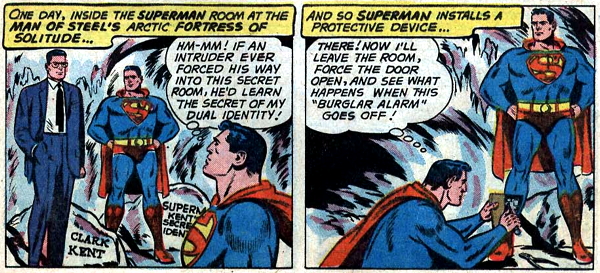
And of course there’s more; there’s always more with the Silver Age. The writers keep noodling on the Fortress of Solitude for years, and by 1961, Superman is making wax figures of himself labeled “Clark Kent” and “Superman, Clark Kent’s Secret Identity”, a distinction that you wouldn’t think that he would need a label to appreciate.
Then, in a moment of very Silver Age reflection, he thinks, “Hm-mm! If an intruder ever forced his way into this secret room, he’d learn the secret of my dual identity!” — and his solution to this non-problem is to attach bombs to the figures’ legs, so that when anyone opens the door, the wax figures would explode…

… which is what happens, while he’s testing the security system.
“Good!” he congratulates himself. “Not a trace is left of the statues! My secret will be safe from intruders! I can easily replace the destroyed statues…”
So at this point, I think we have every right to ask Superman to fill out his timecard in 15-minute increments. Dude, how do you have time for all of this?

And then, he has to go and install the same security system on the statues in the Batman and Robin room, and the ones in the Supergirl room, which also have labels that announce the hero’s secret identity. All of this is to decorate the Fortress for himself, because nobody else is ever allowed to enter, and he is not even done making wax figures yet.

So, Superman, we need to discuss this. Now he’s adding a Hall of Enemies to his private wax museum, including Young Luthor before explosion and after explosion.
Clark, I know you live at super-speed, but there is a limit. You need to go outside. I mean, this is why it’s called Superman’s Fortress of Solitude, and not Superman’s Date Night Pleasure Palace.

Eventually, all the wax figures get pissed off with Superman, and decide to gang up on him. Superman, nobody told you to make all these statues in the first place. Do not come to me with these problems.
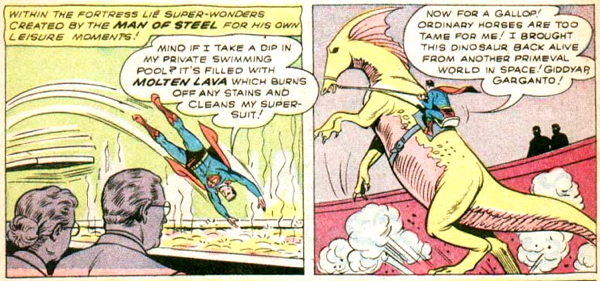
And there’s tons more in the Fortress, too. There’s a swimming pool filled with molten lava, and an intergalactic zoo, including a dinosaur from a primeval world in space that he rides around like a horse, and a giant bowling alley with giant pins, and an art room where he paints a Martian landscape that he can see using his telescopic vision.
By this point, the trophy room is stocked with a giant Jack-in-the-box, and an electronic plastic surgery machine, and an anti-gravity belt, and a “telepathic-sending trophy” for communicating telepathically, which I don’t even understand what that is.
He’s also got a “Super-Univac” in the Fortress that can foretell the future, and a room labeled Forbidden Weapons of Crimedom, and a Zone-ophone to communicate with people in the Phantom Zone, and I haven’t even mentioned that he has a glass bottle filled with the surviving Kryptonian city of Kandor, which was shrunk and stolen from the surface of the planet before Krypton perished and now rests, tiny but hopeful, on some special shelf where Superman will one day enlarge it and return it to its rightful place, which no longer exists.

For my money, the single most exhausting thing in the entire place is Superman’s diary, constructed out of enormous sheets of metal which he inscribes with his super-fingernails, and written in Kryptonese, a language that only he understands. This is late-stage Paul Bunyan-ism, a disorder that manifests in tall-tales characters who have been one-upping themselves for decades, until they get to the point where it really would be a whole lot easier if they just did it the normal way.

The place is a magnet for intruders, too. In the first of the Silver Age Fortress stories, after Superman talks for pages about how nobody could possibly get through the door, we find out that Batman snuck in by hollowing out a space in the key and staying there for several days in order to pull a birthday prank on Superman.

The bottle city of Kandor also provides a steady stream of tiny Kryptonians, for good or ill, who manage to escape from their glass prison on a regular basis. And once somebody’s loose in the Fortress, there are a thousand science-fiction devices to play with, culled from previous stories or just made up on the spot.
As weird as this all is, it’s obvious why Superman writers have returned to the Fortress of Solitude again and again. The thing is bursting with plot contrivances, which can get you into and out of any kind of trouble you can imagine. If you need a spare Superman robot, or a monitor that beeps when an alien spacecraft enters Earth’s atmosphere, or a zoo full of dangerous extraterrestrial creatures who invariably escape and stun humanity, then the Fortress is your answer, every time.
The Fortress is a mystery box, really, that’s filled with your fantasies, needs and deepest fears, a locked room that yearns to be unlocked, to facilitate story progression. The Fortress is a sacred space just begging to be defiled, and out tumble the secrets.

Now, one thing that you may have noticed is that Jor-El has absolutely nothing to do with the Fortress of Solitude, as seen in the comics. From 1942 to 1978, the Fortress has been Superman’s private arts and crafts project, which he built to amuse himself, in increasingly worrisome ways. It’s not a legacy passed down to him by the Allfather, in order to instruct him in the ways of Kryptonian thought.
The Fortress being a communications platform for Jor-El is entirely an invention of the movie, which repurposes the real estate in order to support a different kind of story. Really, Jor-El wasn’t particularly important in the comics; he was acknowledged, but never revered. But this 1978 vision of Jor-El dispensing wisdom from outer space turns out to be durable, and it’s picked up in future movies and TV shows.

Eventually, the movie version wins, with the concept feeding back into the comics, in the eternal natural-selection struggle between competing story elements which sprawls across the decades. In 2006, following the history-rewriting Infinite Crisis storyline, Superman gets tired of his current Fortress that’s in the Amazon rainforest for some reason, and he decides to construct a new one in the Arctic, which he builds by throwing a Kryptonian sunstone into the polar wastes and generating the 1978 model all over again.
Deranged wax museum, super-gymnasium, storehouse for forbidden weapons and final resting place of Pedro’s broken axe, the Fortress of Solitude has been everything we needed it to be, and here in 1978, it transforms itself into an empty shell that we can fill up with lectures and crystals. Let’s go inside, and see.
Tomorrow:
Clark attends a twelve-year
standing-room-only seminar
1.28: Grad School
Footnote:
If you’d like to witness the madness yourself, these are the comics referenced in this post:
- Superman #17 (July-Aug 1942): “Muscles For Sale!”
- Superman #58 (May-June 1949): “The Case of the Second Superman”
- Superman #81 (March-April 1953): “Superman’s Secret Workshop”
- Action Comics #241 (June 1958): “The Super-Key to Fort Superman”
- Action Comics #242 (July 1958): “The Super-Duel in Space”
- Action Comics #245 (Oct 1958): “The Shrinking Superman!”
- Action Comics #247 (Dec 1958): “Superman’s Lost Parents!”
- Action Comics #261 (Feb 1960): “Superman’s Fortresses of Solitude!”
- Superman #142 (Jan 1961): “Flame-Dragon from Krypton!”
- Action Comics #278 (July 1961): “The Super Powers of Perry White!”
- Action Comics #294 (Nov 1962): “The Kryptonite Killer!”
- Action Comics #303 (Aug 1963): “The Monster from Krypton!”
- Superman #195 (April 1967): “The Fury of the Kryptonian-Killer!”
- Action Comics #500 (Oct 1979): “The Life Story of Superman”
- Action Comics #840 (Aug 2006): “Up, Up and Away! part VIII: The Adventures of Superman”
Tomorrow:
Clark attends a twelve-year
standing-room-only seminar
1.28: Grad School
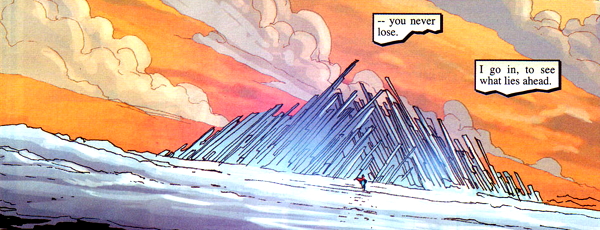
— Danny Horn

The head sculptures of “Young Luthor” are my favorite display. I can picture similar sculptures of Danny Horn before and after “Dark Shadows Every Day.”
LikeLiked by 6 people
Why is Joan Crawford in Superman’s “Hall of Enemies”?
LikeLiked by 5 people
Wait, she’s not in yours???
LikeLiked by 2 people
This is an incredible amount of information. And yet the one feeling I’m having now is a desire to create fanfiction about Pedro’s Broken Axe.
LikeLiked by 5 people
Yeah, that lair is definitely slopping over into “We need to talk about Kal-El” territory. “Gosh golly, Superman, thanks for showing me your cool fortress! Um…gee…this is…not creepy at all….Hey, you know, I just remembered, I have some stuff to do…for a thing…so if we could just head back to Metropolis, that would be super…man…ha ha ha.” As for the other part of Pedro’s axe, I’m guessing it wound up inside Pedro.
LikeLiked by 5 people
So glad you mentioned Doc Savage and his Fortress of Solitude! I only recently read two “original” Lester Dent (aka Kenneth Robeson) novels found at the library (I was trying to avoid the recent re-boot of Doc Savage novels) – “The Man of Bronze” (1933) and “The Hate Genius” (1945), which also included Doc Savage’s female cousin, Patricia (Pat).
Lester Dent, who was a self-styled adventurer himself, developed a formula for writing Doc Savage-style 6,000 word adventure/pulp novels. I think he originally wrote his formula for “Writer’s Digest.” You can easily find different versions of his formula via google. I’m not sure how well Lester’s formula would work in today’s world.
I think Lester is missing one very important point in his outline – it’s your great lit-crit advice, Danny. For readers/audiences to really like a character, that character needs to do at least one of three things (sometimes one or two or all three): (1) make a joke, (2) make a friend, and/or (3) make a plot point happen.
I never knew Superman’s Fortress of Solitude generated so many Silver Age stories.
LikeLiked by 3 people
I wonder if Doc had a special closet in his FoS to keep all those meticulously torn shirts?
LikeLiked by 2 people
It’s great for story generation because it’s a “ship in a bottle,” in that you can whip out any deranged insane piece of whatsit and say well, he had it in his Fortress and he never updates his passwords so eventually said DIS of W put in “Guest” or “11111” or whatever and got out to wreak havoc.
This way you don’t have to bother with an entire story’s worth of backstory; just say Superman captured or showed compassion for the whatsit, depending on plot need, popped in on a shelf, and go from there.
LikeLiked by 1 person
I’ll have to admit the concept of the Fortress is confusing. The opening cartoon panel mentions an interplanetary zoo; that would imply interplanetary zookeepers, as well as a food supply for each specimen – -I would assume the Super-robots can assist there?
But a wax museum in a place where Superman has taken specific measures to keep everyone else out? Even going so far as booby trapping it for destruction? I’m not sure that even my ten-year-old self would buy that one.
And while it’s reassuring that Superman has his affairs in order, and assume that his last will and testament is on file with his lawyers, how is anyone going to get into the Fortress to get Lois’ pearl necklace and Jimmy’s convertible?
Let’s not even go into why there’s a roomful of doomsday devices that can probably incinerate the planet a dozen times over. It’s all good, I’m sure those are checked and maintained regularly…
Come to think, what would anybody have in their Fortress Of Solitude, if they had one?
LikeLiked by 4 people
“Come to think, what would anybody have in their Fortress Of Solitude, if they had one?”
Netflix
LikeLiked by 5 people
It’s also assuming that Jimmy, Lois and etc. are going to outlive him: when it comes to inheriting anything I’m guessing it’s Supes who’s going to tearfully receive Lois’s typewriter.
What to put in my Fortress? Hmmm…I think I’d start a breeding program for all animals wiped out by humans, like dodoes. Yep. Dodo ranching, that’s my dream.
LikeLiked by 3 people
Maybe it’s me, but wouldn’t it easier to not put you and your friends’ secret identities on display?
LikeLiked by 5 people
Well, yes, but then what are you going to do with all those chambers? Just close them off and fill them up with old furniture and suitcases? Superman’s less interesting municipal mementoes?
LikeLiked by 2 people
Yes. This was not a problem that needed to be solved.
LikeLike
I didn’t realize there was a Golden Age FoS until reading Roy Thomas’ ALL-STAR SQUADRON #22 (1983) which also showed Superman practicing in that shoulder-blades machine. Isn’t there a Bronze Age Oversized DC Special devoted to the FoS?
LikeLiked by 3 people
The Earth-2 FoS is also featured in a Mr and Mrs Superman story in Superman Family. In this story set in the 1950s, Supes had been depowered to about 1938 level by Metalo (IIRC), so he and Lois go by leaps and bounds to his fortress so he could work out for a few days. Being Superman, he could build muscle very fast–and again was able to fly, somehow.
LikeLike
As the only kid my age in the neighborhood, I loved loved LOVED the Fortress of Solitude. That was probably the most disappointing part of the movie to me, that instead of the ultimate who-needs-friends playroom it turned the Fortress into an unusually boring and spectacularly uncomfortable school.
LikeLiked by 4 people
Wow. I think Superman has spent entirely too much time alone.
Why would he think that a mostly invulnerable Man of Steel would outlive two mere mortals who basically existed to be rescued from imminent death? And couldn’t Jimmy have introduced him to the concept of a scrapbook? Superman could have made holograms that could attack him just as easily as waxworks and saved so much space.
LikeLiked by 3 people
*Why would he think that a mostly invulnerable Man of Steel would outlive two mere mortals who basically existed to be rescued from imminent death?*
They DO seem to get into a lot of danger, don’t they? Wonder how the rest of the staff manage to stay safe. I mean Superman never has to rescue the sports guy or the theater critic.
LikeLiked by 5 people
Maybe the theater critic does get into danger, but Clark Kent had spent so many evenings at bad plays on that guy’s recommendation that he thinks it’s more important to catalog his collection of wax figures than it is to rescue him.
LikeLiked by 5 people
It’s been years since I sat around reading Silver Age comics, and you’re making me want to again so badly
LikeLiked by 1 person